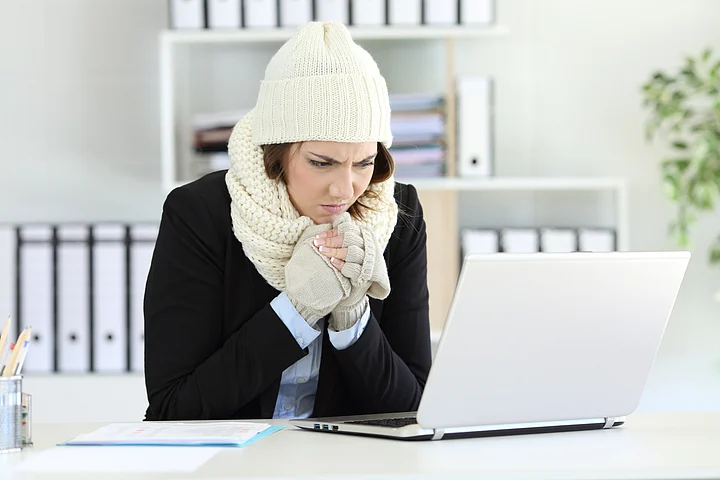Freezing or melting - seems like there are only these two extremes that exist when it comes to workplace temperature. And if you have suffered from them, you’re one of the millions employees all over the world who are fighting it out with each other over the ideal temperature.
This fight is not simply confined to office spaces, but spreads out at home too. About one third couples argue over the ideal temperature and four in every 10 women increase the temperature when they’re partners are not looking, according to this report.
Too caught up to read? Listen to the story here:
Is There a Difference in Body Temperatures Between Genders?

The simple answer is yes. The same report points out that in most office spaces globally, the temperature is adjusted based on the metabolism of an average man. Women on the other hand, have a lower metabolic rate, less muscle and more fat cells which produce less heat, and thus need the temperature higher by about 3C (5.4F).
Dr Rakesh Pandit, Senior Consultant, Internal Medicine, Aakash Healthcare Super Speciality Hospital, Dwarka, comments:
The metabolism of your body is majorly responsible for producing heat and energy. Though women and men both have similar body temperatures internally, in the case of men they usually have more mass and hence they tend to generate more heat by burning down more calories to provide energy to their extra body mass as compared to women. And in the case of women, due to lower metabolic rate, they generate less heat and hence they usually feel colder than men.
Another 2015 study by Dutch scientists concluded that women prefer temperatures 2.5C warmer than men.
Skin temperatures are also lower in women, according to this report. When hands of both men and women were exposed to the cold, a drop of 3C was noticed in women as compared to men.
Why Are Women Colder Than Men?
As mentioned previously, there are several reasons behind it which include their muscle density, metabolic rate, fat and blood flow. Since their skin is marked by a lower blood flow, it results in lower skin temperatures.
Estrogen has a significant role to play when it comes to this for it thickens the blood. This, in turn, restricts the flow of blood to the capillaries and means that women’s toes and fingertips are easily more sensitive to low temperatures than men’s. It’s further concluded that women tend to feel colder around ovulation when the estrogen levels in their body increase.
Additionally, higher muscle mass means higher metabolism which further means higher blood flow, again a process where men are ahead of women, thereby leading to a drop in the latter’s skin temperature.
If medical conditions get added to the mix, women can become more or less sensitive to the cold.
Diseases like anaemia, malnutrition, diabetes, thyroid disorders, vasculitis may make women feel colder or hotter.Dr Rakesh Pandit
Beyond Exceptions and More
While these standards apply to most situations, there are several things at play like hormones and body clocks that can disrupt this. There are instances when women’s core temperatures would be significantly h igher than men’s and these involve pregnancy and hormonal contraceptives. Both of these increase it by 0.5 to 1C, according to this report.
Dr Pandit further points out:
The difference between men and women body temperatures is an age related factor too. Middle aged women who are going through a menopausal phase, generate more heat compared to older aged women due to high hormonal changes in their body. They return to their normal body temperature after menopause, and just the opposite happens to men when they come to their menopause/andropause, as they start losing their extra body mass and thus stop generating extra heat, making them feel colder to temperature they were previously comfortable with.
There is a difference in the body clocks of men and women and it affects the way their bodies react to environmental temperature. If studies are to be believed, women go to bed earlier than men. As a result, they wake up earlier when the mornings are colder. If they feel colder when they wake up, it is because it literally is colder.
However, this is only for the early part of the day. During the day and your work hours, these differences have been covered. Additionally, the distinction is to be made between core temperature and skin temperature. While women’s core temperature might be higher than men during some parts of the day, when it comes to skin, the temperature is less for women than men.
The difference in core body temperatures of men and women is very little and even though women have higher temperature at core organs than men, they have lower temperature at perennial body parts (hands and feet) than men.Dr Rakesh Pandit
Link Between Temperature and Productivity

Now that we have looked at the biology of it all, there is yet another practical concern that is linked to the inequality in body temperatures - effect on work. A UK-based report pointed out about 2 percent of office hours get wasted during fights over the right temperature which costs their economy over £13 billion annually. Similarly, temperature-wars cause loses as high as $6.2 billion in countries like Australia.
If this wasn’t enough, there have been suggestions of links between productivity of employees and adequate workplace temperatures. A comfortably warm temperature is not only believed to improve productivity, but also inter-personal relations. Physical warmth of the environment is believed to encourage emotional warmth as well. The part of the brain that gets activated in response to temperature is the same part of the brain that is associated with feelings of trust and empathy. According to international standards, the ideal workplace temperature falls somewhere between 22C and 25C. (71.6 and 77F).
While an ideal temperature exists in theory, alas, practice remains far from it as temperature wars continue to be waged on.
(At The Quint, we are answerable only to our audience. Play an active role in shaping our journalism by becoming a member. Because the truth is worth it.)
